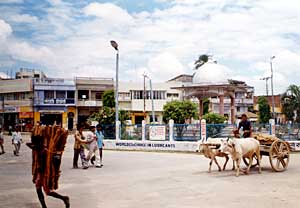 The stagnation and neglect of the Nepal tarai is best symbolised by the one town that once had so much promise: Rajbiraj.
The stagnation and neglect of the Nepal tarai is best symbolised by the one town that once had so much promise: Rajbiraj. It was the first township in Nepal to have urban planning, it had one of the first airfields in the tarai. And while other border cities like Birganj and Biratnagar surged ahead, Rajbiraj was bypassed by the east-west highway and became a backwater.

You wouldn't know it when visiting this sleepy, dusty town in the vicinity of Biratnagar that Rajbiraj is the zonal headquarters of Sagarmatha Zone, named after the world's highest mountain. It is also an indication of Nepal's vertical topography that Mt Everest, 8,848m high is barely 150 km from this town, located at barely 100 m above sea level.
Anju Jha, a resident of Rajbiraj for more than two decades was recently confronted with an agonising dilemma: whether to stay on in her ancestral town or escape in search of better opportunities. The absence of proper educational facilities for her growing children coupled with lack of future prospects for her husband compelled the family to migrate to Kathmandu.
Anju is not an isolated example. With general stagnation in Rajbiraj, more people from diverse backgrounds have been moving out of town for over two decades. Though this phenomenon is prevalent elsewhere in Nepal, Rajbiraj is an extreme example.
The district headquarters of Saptari, Rajbiraj was the earliest planned township in the country. Systematically designed in 1938, it was declared a municipality in 1959. Rajbiraj served as a trade centre, occupying a prominent place in the economy due to the Hulaki highway. Rajbiraj was also the cradle of the democracy movement, where the anti-Rana agitations began with the jail break by political prisoners of the nearby Hanumannagar Prison. How could a place, which had everything going for it, fall behind so dramatically?
 Even northern Bihar has better health and education services, so people of Rajbiraj have moved across the border. While newer tarai towns like Birganj have grown and thrived, Rajbiraj plays a peripheral role in national politics and economy. Jagannath Das, the Rajbiraj mayor admits: "The pace of development in Rajbiraj has been a lot slower than it should have been."
Even northern Bihar has better health and education services, so people of Rajbiraj have moved across the border. While newer tarai towns like Birganj have grown and thrived, Rajbiraj plays a peripheral role in national politics and economy. Jagannath Das, the Rajbiraj mayor admits: "The pace of development in Rajbiraj has been a lot slower than it should have been." There seems to be a consensus here that the construction of the east-west highway which by-passed played a major role in the town's decline. Renu Yadav, MP from the area, believes that Rajbiraj would be a thriving economic centre if the road had passed the town, instead it went through the tiny village of Lahan, to its north. Lahan has now sprung up as a major township and highway junction.
The town used to have an industrial estate, which has now been reduced to a cowshed. Industrialists are reluctant to invest in Rajbiraj because of the lack of infrastructure, and other basic services. This is a Catch 22 situation: there will be no need to invest in highways, electricity and water unless there are industries.
Farming fares no better. Ideally, with its fertile soil, access to irrigation, and its location on the border Rajbiraj should have been a major hub for trade in cash crops. But harvests are stagnant and there is very little innovation. Dirt-poor peasants are just struggling to survive from season-to-season.
Municipal officials, for their part, blame discriminatory policies of the central government for slow development. Citing prejudice against the tarai, Mayor Das sees the capital-centric attitude of Kathmandu-based bureaucrats and politicians as the main reason for this neglect. "Development is confined to the valley," Das told us.
While these might well be contributing factors, Rajbiraj's intelligentsia is quick to point to the failure of the political leadership locally as well.
"Unfortunately, there has been a shortage of leaders committed to development in our town," says Dr Ashokanand Mishra at the Sagarmatha Zonal Hospital. This rings true in the face of glaring political squabbles. Member of parliament, Yadav and Mayor Das, for example trade allegations of incompetence, and pass on the blame for Rajbiraj's decay on each other.
 Kumar Upadhyay, a consultant who has worked extensively in the region believes that the citizens of Rajbiraj must take a share of the blame. Citing statistics, he says that 6,500 cases are filed anually in the district court at Rajbiraj compared to 3,500 cases in neighbouring districts and a mere 150 in the hills. "This illustrates the myopic mindset of the people in Rajbiraj. They prefer to go to court over petty issues instead of resolving disputes amicably and working towards development," he says.
Kumar Upadhyay, a consultant who has worked extensively in the region believes that the citizens of Rajbiraj must take a share of the blame. Citing statistics, he says that 6,500 cases are filed anually in the district court at Rajbiraj compared to 3,500 cases in neighbouring districts and a mere 150 in the hills. "This illustrates the myopic mindset of the people in Rajbiraj. They prefer to go to court over petty issues instead of resolving disputes amicably and working towards development," he says. Despite the general gloom and despondency, there may be a glimmer of hope if immediate action is taken. Kuber Sharma, a Green Party member whose family is from Rajbiraj, suggests the following steps may revive the sagging fortunes of his town:
. Begin a management school of excellence in Saptari, which would attract students and improve the general state of education.
. Strive to make Rajbiraj a software centre by supporting entrepreneurs.
. Develop local agro-industries, for instance fish farming
. Get the Indians to bring a railhead at Kunauli, across the borderd in Bihar.
"Operating an industrial area along with institutionalising better co-ordination among various government agencies is a must if any revival is to take place," says Sharma. But even more essential seems to be a commitment by the local leadership and the citizens to work unitedly for progress.
If that does not happen, Mishra at the zonal hospital foresees Rajbiraj once more missing the bus. "We could become the development hub of the region, but we will be pushed to near anonymity if we don't act," he told us.
While this may be an extreme scenario, it reflects the pessimism of the residents and explains why more people like Anju are migrating. To stop this, there is a need for a concerted effort by civil society and government to launch multi-pronged interventions. However, the big question remains: will Rajbirajans themselves rise up to the task?


